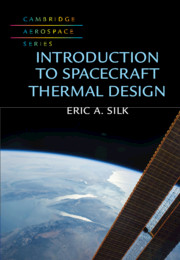Book contents
- Introduction to Spacecraft Thermal Design
- Cambridge Aerospace Series
- Introduction to Spacecraft Thermal Design
- Copyright page
- Dedication
- Contents
- Figures
- Tables
- Nomenclature
- Subscripts
- 1 Introduction
- 2 Conduction Heat Transfer Analysis
- 3 Radiative Heat Transfer Analysis
- 4 The Space Environment
- 5 Space-Based Advanced Thermal Conductance and Storage Technologies
- 6 Sensors, Instrumentation and Test Support Hardware
- 7 Fundamentals of Cryogenics
- 8 Developmental and Environmental Testing
- Book part
- Index
- Solutions
- References
2 - Conduction Heat Transfer Analysis
Published online by Cambridge University Press: 19 June 2020
- Introduction to Spacecraft Thermal Design
- Cambridge Aerospace Series
- Introduction to Spacecraft Thermal Design
- Copyright page
- Dedication
- Contents
- Figures
- Tables
- Nomenclature
- Subscripts
- 1 Introduction
- 2 Conduction Heat Transfer Analysis
- 3 Radiative Heat Transfer Analysis
- 4 The Space Environment
- 5 Space-Based Advanced Thermal Conductance and Storage Technologies
- 6 Sensors, Instrumentation and Test Support Hardware
- 7 Fundamentals of Cryogenics
- 8 Developmental and Environmental Testing
- Book part
- Index
- Solutions
- References
Summary
Thermal conduction is one of the two primary heat transfer mechanisms present on space-based platforms. The goal of this chapter is to establish proficiency in the design and interpretation of thermal conductance resistance networks. The geometries studied are assemblies and/or sub-assemblies with multiple components of variable shapes and sizes.
- Type
- Chapter
- Information
- Introduction to Spacecraft Thermal Design , pp. 13 - 63Publisher: Cambridge University PressPrint publication year: 2020



